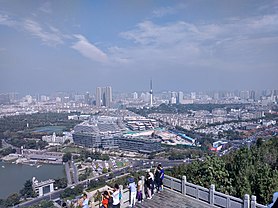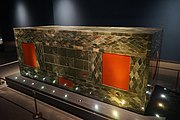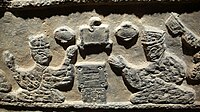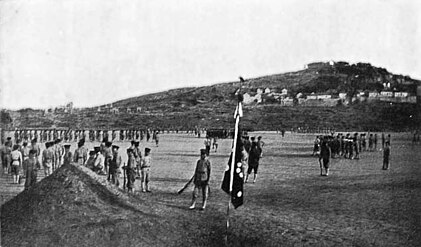
A | B | C | D | E | F | G | H | CH | I | J | K | L | M | N | O | P | Q | R | S | T | U | V | W | X | Y | Z | 0 | 1 | 2 | 3 | 4 | 5 | 6 | 7 | 8 | 9
This article's use of external links may not follow Wikipedia's policies or guidelines. (May 2018) |
Xuzhou
徐州市 Hsü-chou, Süchow | |
|---|---|
Left to right, top to bottom: Xuzhou skyline, Huaihai campaign Memorial Park, Surabaya Pavilion in Sishuiting Park, Yunlong Lake, the Xuzhou TV Tower | |
 | |
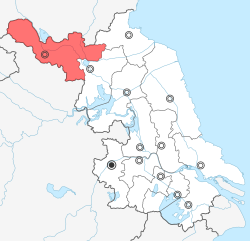 Location of Xuzhou City jurisdiction in Jiangsu | |
| Coordinates (Pengcheng Square): 34°15′54″N 117°11′13″E / 34.265°N 117.187°E | |
| Country | People's Republic of China |
| Province | Jiangsu |
| County-level divisions | 10 |
| Township-level divisions | 161 |
| Municipal seat | Yunlong District |
| Government | |
| • Mayor | Zhou Tiegen (周铁根) |
| • CPC Committee Secretary | Zhang Guohua (张国华) |
| Area | |
| • Prefecture-level city | 11,259 km2 (4,347 sq mi) |
| • Urban | 3,037 km2 (1,173 sq mi) |
| • Metro | 2,347 km2 (906 sq mi) |
| Population (2020 census)[1] | |
| • Prefecture-level city | 9,083,790 |
| • Density | 810/km2 (2,100/sq mi) |
| • Urban | 3,589,215 |
| • Urban density | 1,200/km2 (3,100/sq mi) |
| • Metro | 3,135,660 |
| • Metro density | 1,300/km2 (3,500/sq mi) |
| GDP[2] | |
| • Prefecture-level city | CN¥ 732 billion US$ 106 billion |
| • Per capita | CN¥ 80,615 US$ 11,683 |
| Time zone | UTC+8 (China Standard) |
| Postal codes | 221000 (Urban center), 221000, 221000, 221000 (Other areas) |
| Area code | 0516 |
| ISO 3166 code | CN-JS-03 |
| Major Nationalities | Han |
| Licence plate prefixes | 苏C |
| Website | Archived link |
| Xuzhou | |||||||||||
|---|---|---|---|---|---|---|---|---|---|---|---|
"Xuzhou" in Chinese characters | |||||||||||
| Chinese | 徐州 | ||||||||||
| Postal | Suchow | ||||||||||
| |||||||||||
| Pengcheng | |||||||||||
| Chinese | 彭城 | ||||||||||
| |||||||||||
Xuzhou (Chinese: 徐州), also known as Pengcheng (彭城) in ancient times, is a major city in northwestern Jiangsu province, China. The city, with a recorded population of 9,083,790 at the 2020 census (3,135,660 of which lived in the built-up area made of Quanshan, Gulou, Yunlong and Tongshan urban Districts and Jiawang District not being conurbated), is a national complex transport hub and an important gateway city in East China. Xuzhou is a central city of Huaihai Economic Zone and Xuzhou metropolitan area.[3] Xuzhou is an important node city of the country's Belt and Road Initiative, and an international new energy base. Xuzhou has won titles such as the National City of Civility (全国文明城市) and the United Nations Habitat Scroll of Honour award.
The city is designated as National Famous Historical and Cultural City since 1986 for its relics, especially the terracotta armies, the Mausoleums of the princes and the art of relief of Han dynasty.
Xuzhou is a major city among the top 500 cities in the world by scientific research outputs, as tracked by the Nature Index.[4] The city is also home to China University of Mining and Technology, the only national key university under the Project 211 in Xuzhou and other major public research universities, including Jiangsu Normal University, Xuzhou Medical College, and Xuzhou Institute of Technology.[5]
Romanization
Before the adoption of Hanyu Pinyin, the city's name was typically romanized as Suchow[6] or Süchow,[7][8] though it also appeared as Siu Tcheou ,[9] Hsu-chou,[10] Hsuchow,[11] and Hsü-chow.[8][12]
History
Early history
The early prehistoric relics around Xuzhou are classified as Dawenkou culture system. Liulin (劉林) site together with Dadunzi (大墩子) site, Huating (花廳) site, and Liangwangcheng (梁王城) site correspond to the initial, middle and late stages of this culture, respectively.[13] While the remains of sacrificial rituals performed to Tudi deity found at Qiuwan (丘灣) site and Gaohuangmiao (高皇廟) site, both of them are in the outskirts of the city, indicate that Shang dynasty affected the area.[14] History relates that Peng or Great Peng, the transitions from a tribe to a chiefdom contained within the boundary of the city. Peng Zu is believed to be the first chief of the ancient Peng state that was centered around Xuzhou, while the state was eventually conquered by King Wu Ding of Shang in around 1208 BC.[15][16]
During the time of Western Zhou, a Huaiyi chiefdom called Xuyi or Xu rose centered around Xuzhou and controlled the Lower Yellow River Valley. Xuyi with its Huaiyi people fought against Zhou and its vassals at irregular intervals. Since its declining, Xuyi once moved the capital to the area of Xuzhou and populated it with people who were migrated southwards.
Pengcheng, named after the ancient Peng state that was centered around Xuzhou, a city at the junction of the ancient Bian and Si Rivers, was founded by Lü (annexed by Song later). Chu took the city in the war of 573 BCE, but ceded the city back to Song in the next year, as a coercive measure.[17]
Imperial China
In 208 BC, Xiang Yu and Liu Bang deployed their troops into Pengcheng, where Emperor Yi of Chu later transferred his capital from Xuyi after rebel leader Xiang Liang's death.[18][19] Xiang Yu then exiled the emperor to southern China in 206 BC, the former proclaiming himself as "Hegemon-King of Western Chu", and also establishing his capital in Pengcheng, until 202 BC.
During the Han dynasty, a new Chu Kingdom was established with its capital at Pengcheng. It was ruled by various imperial princes during the Western Han period (202 BC – 9 AD). Liu Jiao, the younger half-brother of Liu Bang, became the first Prince of Chu. In 154 BC, the prince Liu Wu participated in the Rebellion of the Seven Princes. However, he was defeated afterwards and Chu's territories were greatly diminished. By the end of the second century, a prosperous Buddhist community had been settled at Pengcheng.[20]
-
Liu Wu's lacquered wood coffin inlaid with jade
-
Liu Wu's jade shroud sewn with gold threads
-
A relief depicting two men gambling
At the turn of the second century, Pengcheng changed hands several times among Cao Cao and his rivals before being annexed to Cao Wei in about 200. In the intervening years, the seat of Xuzhou (Xu province) was transferred from Tancheng to Xiapi, which located in the northwest of Suining. While Pengcheng became the seat later than 220.
With the rebellions of the Five Barbarians, considerable local households migrated to the south, a Liu clan from Pengcheng ascended to the gentry, its most well known descendant is Liu Yu, the Emperor Wu of Liu Song. Pengcheng was taken by the Northern dynasties later. Liu Yu recaptured the lost territory in the north of the Huai River in about 408. Xuzhou was divided into two parts: Beixuzhou (North Xuzhou) and Xuzhou (with Jingkou as its seat) in 411. North Xuzhou whose seat was Pengcheng bounded on the south by the Huai River. Beixuzhou was restored as Xuzhou a decade later, while its south counterpart was renamed Nanxuzhou (South Xuzhou). Since then, Pengcheng remained being the seat of Xuzhou until it was eliminated in the early Ming.
The raging wars inflicted upon Xuzhou until the Emperor Taizong of Tang's enthronement in 626. Keeping the northern rebellions and warfare a distance gave Xuzhou scope for developing during the most period of the Tang dynasty. According to the Old Book of Tang and the New book of Tang, in 639, the total population of Pengcheng County, Fei County and Pei County was only 21,768, versus 205,286 in 742.[21]
In 781, Li Na marched south to besiege Xuzhou. Although his revolt was quell soon, the halt of the transport by the Bian Canal impelled the court to secure the area.[22]
The then prefect of Xuzhou, Zhang Jianfeng was designated as the first military governor of Xuzhou–Sizhou–Haozhou (徐泗濠節度使) which was headquartered in Xuzhou since 788. The title was restored and renamed Wuning (武寧) in 805, after an interval of five years. Wang Zhixing, another military governor of Wuning, established several battalions (the most notorious one among is the Silver Sword) in the Army specifically for select recruits. These soldiers not only defy military discipline but also show defiant towards the successors to Wang. In 832, Li Ting received a threatening letter prior to his induction in there, made him resigned immediately.[23] Then Wuning suffered mutinies in 849, 859 and again in 862.[24] Another two governors were expelled.[25] Wang Shi was appointed, under the circumstances. He put the mutiny down by executing part of the garrison troops and disbanded the rest, which became thugs and loot later. In 864, the court declared an amnesty in the area, and promised that all thugs who willingly re-enrolled would be sent for a tour of duty in the southern, and then, presumably, returned to regular army service in the north.[26]
Three thousand men surrendered and were sent to the south to join the two thousand former Wuning soldiers there. The breached pledge irritated them. Led by Pang Xun, some soldiers mutinied and marched back north.[27] They have unimpeded access to the area by the winter of 868.[28] The local civil governor refused Pang's demand to have the hatred officers removed, and a military confrontation ensued. Thousands of local peasants joined the rebels. They took the prefectural city of Xuzhou, captured the civil governor, and killed those officers. Pang acquired a considerable following. Still, the rebellion was suppressed a year later eventually. Wuning was renamed Ganhua (感化; 'Converting "') with admonishment on lest the garrison to revolt again.[29]
After the Yellow River began to change course during the Song dynasty, heavy silting at the Yellow River estuary forced the river to channel its flow into the lower Huai River tributary. The area became barren thereafter due to persistent flooding, nutrient depletion and salination of the once fertile soil.
In the first month of 1129, Nijuhun took the city after a siege of 27 days, and the then governor Wang Fu (王復) was executed for refusing to submit. Wang's inferior Zhao Li (趙立) rallied the remains and constructed a local militia. They recaptured the city two months later but withdrew from there strategically soon. Henceforth, Xuzhou was ruled by Jurchen over a century.[30]
In 1232, the general Wang You (王佑), Feng Xian (封仙) revolted, they expelled the Jurchen's governor Tuktan. Then the Mongolian army led by Anyong (安用), a Han Chinese general captured Xuzhou soon. Both the general of the state of Su (宿州) Liu Anguo (刘安国) and the general of Pizhou Du Zheng (杜政) yielded their owned city to Anyong. Regarding Anyong's behave as grabbing reputation, the Mongolian general Asuru (Chinese: 阿术鲁/额苏伦) irritated and persisted to kill him. Felt panic, Anyong sought refuge from Jurchen.[31] The Jin dynasty resumed its ruling in Xuzhou, and it was quite transient. The serious disunity made betraying recur. In November 1233, the garrison of Xuzhou welcomed the Mongolian.[32] Meantime, Anyong pledged loyalty to the Song dynasty. He captured the city again after the Mongolian army left. In the spring of the next year, the Mongolian commander Zhang Rong (张荣) attacked Xuzhou,[33] Anyong drowned himself after the final defeat.[31] The Mongolian governor of Xuzhou and Pizhou called Li Gaoge (李杲哥) surrendered to the Song in 1262. Then he failed and was killed after several days.[34]
A rebellion against Yuan rose by Li Er (李二) who was nicknamed Sesame Li in the area around Xuzhou. In the eighth month of 1351, they took the city. Toghon Temür gave an edict that they would be granted amnesty if they surrendered to the authority, in the spring of the next year. The rebels ignored that, so he agreed that Toqto to suppress the unrest. The city fell in the autumn, and the multitudes were killed by Toqto's army afterwards.[35] It may be the symbolically most important victory for Toqto.[36] Thus, Xuzhou was renamed Wu'an (武安; literal meaning: Restoring peace by force") as a favour for him, and a stone slab celebrating his deed was erected by the court in the city.[37]
Zhang Shicheng occupied Xuzhou as the northernmost city of his domain in 1360.[38] The Ming forces under Xu Da, captured Xuzhou in 1366.[39] Soon Köke Temür sent an army under General Li Er to attack Xuzhou. Fu Youde (傅友德) and Lu Ju (陸聚) who held the city raided them outside, most of the enemy were drowned while the remained about 270 soldiers and 500 horses were captured.[40]

Xuzhou had a long period of prosperity during the Ming dynasty. The flourishness largely attributed to the carriage, especially by the Grand Canal,[41] one of seven customs barriers (or customs houses, 鈔關) under the Ministry of Revenue was located in Xuzhou.[42] It was retained until the late Qing.[43] Korean Choe Bu affirmed that the city where he travelled by way of, hardly pale by comparison to the Jiangnan region.[44]
As a hub for both the national courier system and the grain tribute system for several centuries, Xuzhou was of vital importance.[45] Thus, the government of Ming established three garrison areas namely guards in the present-day area: Xuzhou guard (徐州衛), Xuzhou Left guard (徐州左衛) and Pizhou guard (邳州衛) for its security.
Yet, the local navigation was considerably constrained by two Rapids: the Xuzhou Rapids (徐州洪), a kilometer southeast of the city, and the Lüliang Rapids (呂梁洪), another 24 kilometers further south.[46] The remedy provided by the Ministry of Works is constructing the Jia Canal, which paralleled the treacherous stretch of Xuzhou. However, the canal completed in the 1600s ravaged the city. Not only it disrupted the former drainage system, but also depressed the local economy.[47] Prior to the recession, flooding and the famines followed struck Xuzhou frequently.[48] The worst flooding occurred in 1624: it was immersed up to 1 zhang and 3 chi (about 4m) within the city.[49]
After the Hongguang Emperor enthroned in Nanjing, the court designated four defense areas along the southern bank of the Yellow River (江北四鎮) to repulse the Qing armies. While the former bandit general, Gao Jie (高傑) was designated to take the crucial forward position at Xuzhou by Shi Kefa.[50] But the assassination of Gao seriously reduced the court's capacity to deal with challenges from Qing.[51] Gao's successor was Li Chengdong (李成棟). Being aware of forthcoming attack, Li deserted Xuzhou in the early summer of 1645. Then Dodo's army captured the city.

The seismic activity of the Tancheng earthquake in 1688 was also involved Xuzhou. "More than half the houses of the city were ruined" and "led to enormous deaths", according to the gazetteer.[52]
In the 1850s, the Yellow River shifted its course from the southern to the northern side of the Shandong peninsula, the process caused serious floods and famine in Xuzhou, and almost made the waterway system within the prefecture defunct.
Modern China
Zhang Xun and his remaining army fled to Xuzhou after the Revolution of 1911. They entered the city on 5 December. The Nanking Government sent three armies to attack Xuzhou. In the middle of February 1912, Zhang evacuated the city and moved north after he was defeated.
Since the Second Revolution began, Xuzhou became a front-line city. The Revolutionary Army fared badly as it advanced from there towards the north, and a rout ensued. Then the Beiyang Army captured the city on 24 July. Thereafter, Zhang Xun made Xuzhou his base. he convened four meetings of the Beiyang leadership. Involved the stalemate among Li Yuanhong and Duan Qirui in 1917, he marched on Beijing with a troop in June. His failure spread and caused a terrible wave of theft and arson committed by his garrisons later in Xuzhou in July.
The Zhili clique dominated Xuzhou by 1924. In the autumn of this year, the Second Zhili–Fengtian War broke out, Zhang Zongchang who supported the Fengtian clique seized the city with his thirty thousand soldiers. Sun Chuanfang led a coalition of forces to sortie the Fengtian Army in October 1925. They occupied the city on 8 November. As the leader of the Northern Expedition, Chiang Kai-shek arrived in Xuzhou on 17 June 1927.[53] He conferred with Feng Yuxiang and other Kuomintang officers on 20 June, Feng was courted by Nanjing.[54] Then Sun Chuanfang and Zhang Zongchang began to fight in unison against the Nationalist government. They captured the city on 24 June. The fall of Xuzhou aroused public outrage, Chiang 's first resignation ensued. On 16 December, Nanjing force took the area again.[55]

The area was the main site both of the Battle of Xuzhou in 1938 against the Japanese Army in the Second Sino-Japanese War and of the battle in the Chinese Civil War, the Huaihai Campaign in 1948–49.
On 19 May 1938, Chiang gave the order to abandon Xuzhou, then Japanese military took control of the city.
The Administrative Commission of the Su-Huai Special Region (蘇淮特別區) was established in January 1942, with its seat at Xuzhou. It was replaced by a new puppet province, Huaihai (淮海省). Hao Pengju was appointed as the governor.[56]
After the Second Sino-Japanese War, the troop under He Zhuguo entered Xuzhou on 6 September. The Xuzhou Pacification Commission (徐州綏靖公署) was founded in the end of year, and Gu Zhutong was appointed as the Chief. It was disbanded when the Army Command Headquarters of transferred to Xuzhou on 5 March 1947. Meantime, a military tribunal attached to the commission was organized to sentence 25 Japanese soldiers.[57][58]
Guo Yingqiu as the representative of the CPC went to Xuzhou to negotiate a regional truce, since 10 February 1946. On 2 March, the "Committee of Three", comprising George Marshall, Zhang Zhizhong and Zhou Enlai arrived for the ceasefire in Central China. Still, the KMT and the CPC came into conflict soon. The CPC revealed that Yasuji Okamura assisted the KMT in the local warfare against the PLA.
The Huaihai was the a critical of the trinity of the major campaigns during the Chinese Civil War. Fighting centred around the city of Xuzhou, seat of the Bandit Suppression Headquarters (剿匪總司令部) established on 6 June 1948. It turned into a fiasco, which led to the fall of the Nationalist Chinese capital Nanjing.[59] The CPC controlled the city on 1 December.
-
Zhang Xun's troops in Xuzhou, the 1910s
-
Chiang Kai-shek conferred with Feng Yuxiang in Xuzhou, 1927
-
The "Committee of Three" met in Xuzhou, 1946
-
Mao Zedong at the platform of Xuzhou Railway Station in 1953
Then Xuzhou (the old urban area) was made a part of Shandong province temporarily, together with the rest area of the northern Jiangsu along the Longhai Railway. The city was returned to Jiangsu as the province was restored in 1953.
The railways in Xuzhou bore the brunt of the transporting muddle in the 1970s, Beijing was concerned with the issue in 1974. Thus, the then Minister of Railways, Wan Li went to Xuzhou to inspect and rectify in March. It was deemed as a breakthrough on restoring order later.[60]
On April 22, 1993, Xuzhou was ratified as a "Larger Municipality" with legislative power by the State Council.[61]
Administration
The evolutionary history
| The table of local administrative changes | |||||||
|---|---|---|---|---|---|---|---|
| Period | Provincial Level | Prefectural Level | County Level | ||||
| Spring and Autumn |
Song (state) 宋國 |
Pengcheng 彭城 Liuyi 留邑 Lüyi 呂邑 | |||||
| Zhongwu (state) 鐘吾國 | |||||||
| Warring States |
Chu (state) 楚國 | Peiyi 沛邑 | |||||
| Qi (state) 齊國 | Changyi 常邑 | ||||||
| Pi (state) 邳國 | |||||||
| Qin dynasty | Sishui Commandery 泗水郡 |
Pei County 沛縣 Pengcheng County 彭城縣 Liu County 留縣 Xiao County 蕭縣 | |||||
| Donghai Commandery 東海郡 | Xiapi County 下邳縣 | ||||||
| Western Han | Xu Province 徐州(古代,刺史部) |
Chu (state) 楚國 | Lü County 呂縣 Wuyuan County 武原縣 | ||||
| Donghai Commandery 東海郡 |
Siwu County 司吾縣 Marquis Jianling's state 建陵侯國 Marquis Liangcheng's state 良成侯國 Marquis Rongqiu's state 容丘侯國 | ||||||
| Yu Province 豫州(古代,刺史部) |
Pei Commandery 沛郡 |
Pei County 沛縣 Feng County 豐縣 Guangqi County 廣戚縣 | |||||
| Eastern Han and Three Kingdoms |
Xu Province 徐州(古代,刺史部) |
Pengcheng (state) 彭城國 |
Pengcheng County 彭城縣 Liu County 留縣 Lü County 呂縣 Wuyuan County 武原縣 Guangqi County 廣戚縣 | ||||
| Xiapi (state) 下邳國 |
Xiapi County 下邳縣 Liangcheng County 良成縣 Siwu County 司吾縣 | ||||||
| Yu Province 豫州(古代,刺史部) |
Pei (state) 沛國 |
Pei County 沛縣 Feng County 豐縣 | |||||
| Jin dynasty, Northern and Southern dynasties |
(North) Xuzhou or (North) Xu Province (北)徐州 South Xuzhou or South Xu Province 南徐州, located in modern Zhenjiang, see Zhenjiang |
Pengcheng Commandery 彭城郡 |
Pengcheng County 彭城縣 Liu County 留縣 Lü County 呂縣 | ||||
| Xiapi Commandery 下邳郡 |
Xiapi County 下邳縣 Liangcheng County 良成縣 Siwu County 司吾縣 | ||||||
| Pei Commandery 沛郡 |
Pei County 沛縣 Feng County 豐縣 | ||||||
| Jiyin Commandery 济阴郡 |
Suiling County 睢陵縣 | ||||||
| Sui dynasty | Pengcheng Commandery 彭城郡 |
Pengcheng County 彭城縣 Liu County 留縣 Pei County 沛縣 Feng County 豐縣 | |||||
| Xiapi Commandery 下邳郡 |
Xiapi County 下邳縣 Liangcheng County 良城縣 | ||||||
| Tang dynasty | Henan Circuit 河南道 |
Xuzhou 徐州 |
Pengcheng County 彭城縣 Pei County 沛縣 Feng County 豐縣 | ||||
| Sizhou 泗州 | Xiapi County 下邳縣 | ||||||
| Northern Song |
West Jingdong Circuit 京東西路 |
Xuzhou 徐州 |
Pengcheng County 彭城縣 Pei County 沛縣 Feng County 豐縣 Baofeng Jian* 寶豐監 Liguo Jian* 利國監 | ||||
| East Jingdong Circuit 京東東路 |
Huaiyang Military 淮陽軍 |
Xiapi County 下邳縣 | |||||
| Jin | West Shandong Circuit 山东西路 |
Xuzhou 徐州 | Pengcheng County 彭城縣 Feng County 豐縣 | ||||
| Huaiyang Military 淮陽軍 | Xiapi County 下邳縣 | ||||||
| Tengzhou 滕州 | Pei County 沛縣 | ||||||
| Yuan dynasty | Henanjiangbei Province 河南江北行中書省 |
Gui’de-fu 歸德府 |
Xuzhou 徐州 | Xiao County 蕭縣 | |||
| Pizhou 邳州 | Xiapi County 下邳縣 Suining County 睢寧縣 | ||||||
| Branch Secretariats 中書省 |
Jining Circuit 濟寧路 |
Jizhou 濟州 | Pei County 沛縣 | ||||
| Feng County 豐縣 | |||||||
| Ming dynasty | Nanquin/South Zhil 南京/南直隸 |
Xuzhou (as an Independent Department) 徐州 |
Pei County 沛縣 Feng County 豐縣 Xiao County 蕭縣 Dangshan County 碭山縣 | ||||
| Huaian-fu 淮安府 | Pizhou 邳州 | ||||||
| Qing dynasty, during 1733–1911 |
Kiangsu/Jiangsu Province 江蘇省 |
Xuzhou-fu (as a Prefecture) 徐州府 |
Tongshan County 銅山縣 Pei County 沛縣 Feng County 豐縣 Xiao County 蕭縣 Dangshan County 碭山縣 Suining County 睢寧縣 Suqian County 宿遷縣 Pizhou 邳州 | ||||
| Republic of China, during 1945–1949 |
Kiangsu/Jiangsu Province 江蘇省 |
Xuzhou City 徐州市 | |||||
| No.9 Administrative Superintendent District 第九督察區 |
Tongshan County 銅山縣 Pei County 沛縣 Feng County 豐縣 Xiao County 蕭縣 Dangshan County 碭山縣 Suining County 睢寧縣 Pi County 邳縣 | ||||||
| People's Republic of China, during 1949–1952 |
Shandong Province 山东省 |
Xuzhou City 徐州市 | Tongshan County 铜山县 | ||||
| Prefecture of Teng County 滕县专区 |
Tongbei County 铜北县 Pei County 沛县 Feng County 丰县 | ||||||
| Prefecture of Linyi 临沂专区 |
Pi County 邳县 | ||||||
| Administrative Region of the Northern Anhui 皖北行署区 |
Prefecture of Su County 宿县专区 |
Xiao County 萧县 Dangshan County 砀山县 | |||||
| People's Republic of China, in 1955 |
Jiangsu Province 江苏省 |
Xuzhou City 徐州市 |
Gulou District 鼓楼区 Yunlong District 云龙区 Zifang District 子房区 Wangling District 王陵区 Jiawang Mining District 贾汪矿区 | ||||
| Prefecture of Xuzhou 徐州专区 |
Xinhailian City 新海连市 Tongshan County 铜山县 Pei County 沛县 Feng County 丰县 Suining County 睢宁县 Pi County 邳县 Xinyi County 新沂县 Donghai County 东海县 Ganyu County 赣榆县 | ||||||
| Anhui Province 安徽省 |
Prefecture of Su County 宿县专区 |
Xiao County 萧县 Dangshan County 砀山县 | |||||
| People's Republic of China, in 1963 |
Jiangsu Province 江苏省 |
Xuzhou City 徐州市 |
Gulou District 鼓楼区 Yunlong District 云龙区 Jiawang Town 贾汪镇 Jiaoqu 郊区(办事处) | ||||
| Prefecture of Xuzhou 徐州专区 |
Tongshan County 铜山县 Pei County 沛县 Feng County 丰县 Suining County 睢宁县 Pi County 邳县 Xinyi County 新沂县 Donghai County 东海县 Ganyu County 赣榆县 | ||||||

